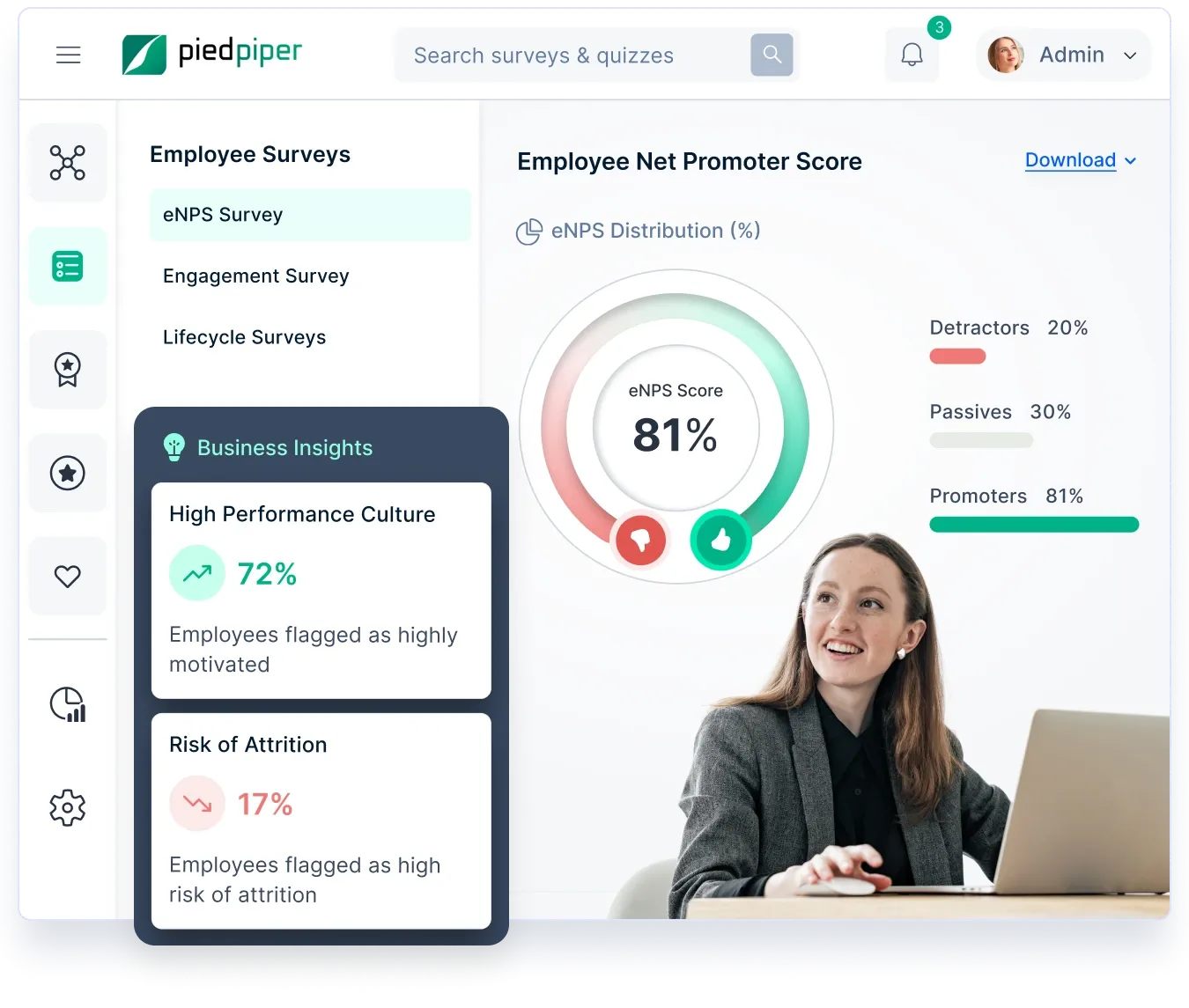Tinjauan Penglibatan Pekerja: Cara Menangkap Maklum Balas Tulen
Tinjauan penglibatan pekerja ialah alat yang berkuasa untuk memahami sentimen tempat kerja dan meningkatkan pengalaman pekerja. Tetapi mengumpul maklum balas hanyalah langkah pertama—mengetahui cara menyampaikan hasil tinjauan penglibatan pekerja dengan berkesan memastikan cerapan membawa kepada perubahan sebenar.
Pada halaman ini
- Apakah tinjauan penglibatan pekerja?
- Kepentingan tinjauan penglibatan pekerja
- Tinjauan sebagai kaedah pengumpulan data
- Penunjuk utama penglibatan pekerja
- How to create and run an employee engagement survey that drives real change
- What should be done with the employee engagement survey results?
- Capture real employee sentiment with Empuls’ engagement surveys
- Pengambilan kunci
- Soalan Lazim
An employee engagement survey isn’t just about collecting feedback—it’s about understanding what truly motivates your workforce and turning insights into action. Simply gathering responses won’t drive change; the real value lies in employee engagement survey analysis and how the results are used to create a better workplace.
But here’s the challenge—surveys can backfire if employees feel their feedback disappears into a black hole. That’s why knowing how to communicate employee engagement survey results is just as important as the survey itself. Transparency, clear follow-ups, and real action based on feedback build trust and encourage employees to share honest opinions.
In this blog, we will walk you through not just designing a powerful employee engagement survey, but also decoding responses, sharing findings effectively, and making tangible improvements that boost morale, retention, and productivity. Because a survey isn’t just a tool—it’s a conversation that shapes the future of your workplace.
Apakah tinjauan penglibatan pekerja?
An employee engagement survey is a set of questions designed to gauge the engagement level of teams, departments, and the company overall. While the concept is simple, measuring engagement can be more complex than it seems.
Organizations use various methods—some rely on the Gallup Q12 (12 key questions), others conduct an in-depth annual survey, and many prefer shorter, more frequent pulse surveys like the employee net promoter score. All these methods aim to measure engagement, so choose one that fits your goals and budget.
Remember, engagement surveys differ from employee satisfaction surveys. An employee might be satisfied with their salary or location but still be disengaged if their work feels monotonous or overly controlled, which can negatively impact business performance.
Kepentingan tinjauan penglibatan pekerja
Employee engagement surveys provide a space where employees can communicate any concerns or issues, they have. It isn’t always possible to interact with their employers individually, especially in larger workspaces.
Dalam kes ini, mudah untuk sebarang kebimbangan tidak disedari kerana tidak ada ruang di mana komunikasi yang jelas boleh berlaku. Kaji selidik ialah cara terbaik untuk mengenal pasti dan menyelesaikan sebarang isu pekerja.
Dengan meletakkan usaha dan menggunakan maklum balas pekerja anda, anda boleh memperbaiki perkara dalam ruang kerja untuk membuat mereka berasa lebih bahagia. Ini akan membuat pekerja anda merasa didengar, dihargai, dan disertakan - yang merupakan faktor utama dalam kepuasan kerja.
Employee engagement surveys are a quick yet effective method of improving employee satisfaction. You can boost your business's productivity and success by conducting them and making improvements based on them.
Tinjauan sebagai kaedah pengumpulan data
Tujuan utama tinjauan penglibatan pekerja adalah untuk mendapatkan maklumat mengenai pendapat, motif, dan penilaian orang, mengenai keadaan dan kesedaran individu kumpulan.
Data yang dikumpul melalui kaedah kaji selidik menyatakan pandangan subjektif responden. Mereka perlu dibandingkan dengan maklumat yang bersifat objektif, yang mesti dibangunkan dengan cara lain.
The development of a research program should precede the survey, a clear definition of goals, objectives, concepts (categories of analysis), hypotheses, objects, and subjects, as well as research tools.
Each survey involves an ordered set of questions (a questionnaire) that serves to achieve the research goal, solve its problems, and prove or disprove a hypothesis.
The wording of the items must be carefully considered in many ways, but, above all, it must be used to fix categories of analysis.

Download Free Survey Templates to Improve Employee Experience
Get pre-built survey templates to measure engagement, gather insights, and enhance workplace culture. Find the right template in just a few clicks.
Penunjuk utama penglibatan pekerja
Sekarang kita telah memahami apa tinjauan penglibatan pekerja, mari kita lihat petunjuk yang paling penting dalam penglibatan pekerja? Mereka mungkin mengejutkan anda sedikit!
1. Percaya kepada rantaian arahan
Katakan pekerja anda tidak merasakan bahawa mereka boleh mempercayai maklumat yang mereka dapat daripada pengurus langsung mereka, ketua jabatan, atau peringkat atas syarikat anda.
Dalam kes itu, mereka akan mula berasa seperti mereka tidak diperlakukan sebagai orang dewasa profesional yang dikendalikan dengan kejujuran.
Mendapatkan terlalu banyak putaran dan perbincangan berganda dari tahap yang lebih tinggi boleh merendahkan atau mengecewakan dan mengurangkan komitmen emosi organisasi.
2. Pengiktirafan yang kerap dan adil
Adakah pekerja anda tahu apabila mereka telah melakukan kerja yang hebat dalam tugas - sama ada projek besar atau kerja kecil? Adakah anda mempromosikan tingkah laku ini di seluruh organisasi untuk memberitahu pekerja tentang kejayaan dan kerja keras itu diiktiraf dan dihargai?
If you’re not, you’re missing out on a big driver of engagement. If your recognition strategy is based on a concept like “Employee of the Month,” where everyone is recognized similarly, no one will truly feel recognized.
Memastikan ganjaran peribadi dan berdasarkan prestasi adalah amalan terbaik yang disahkan oleh SHRM.
3. Meminta maklum balas
Simply asking employees for their opinions in a thoughtful, purposeful way can slightly increase engagement.
Pekerja anda suka ditanya apa yang mereka fikirkan tentang kehidupan di syarikat anda - ia menunjukkan anda menghargai pendapat dan maklum balas mereka.
Sudah tentu, untuk mendapatkan rangsangan penglibatan daripada meminta maklum balas, anda perlu meletakkan perubahan yang dicadangkan oleh pekerja untuk bertindak cukup kerap untuk menunjukkan bahawa anda benar-benar mendengar apa yang mereka katakan. Di sinilah pelan tindakan pasca tinjauan sangat berguna.
How to create and run an employee engagement survey that drives real change
A successful employee engagement survey isn’t just about collecting feedback—it’s about gathering insights that lead to measurable improvements. Many organizations struggle with engagement not because they lack data, but because their surveys fail to uncover real sentiment, key concerns, and actionable solutions.
To get meaningful, data-driven results, organizations must structure their surveys strategically. Here’s a step-by-step breakdown of how to create and run an engagement survey that drives real change—not just reports numbers.
1. Define a clear objective tied to business outcomes
Instead of vague goals like “measuring engagement,” link the survey to specific business challenges. Are you trying to reduce turnover? Improve leadership effectiveness? Identify productivity blockers? A well-defined objective helps frame the right questions and ensures that survey data translates into action.
2. Ask the right questions to uncover root causes
Many engagement surveys focus on surface-level indicators—job satisfaction, work-life balance, or leadership perception—but fail to dig deeper into the ‘why’. A powerful survey balances quantitative and qualitative questions to pinpoint areas that need attention.
- Instead of just asking, “Do you feel valued at work?”, follow up with “What specific actions from leadership make you feel valued?”
- Move beyond engagement scores by asking, “What barriers prevent you from being more engaged in your role?”
- Leverage Empuls employee engagement survey templates, which include structured questions designed to uncover actionable insights.
3. Ensure anonymity to encourage honest feedback
Employees hesitate to share critical feedback when they fear repercussions. Empuls ensures survey anonymity while providing HR teams with AI-driven insights, making it easier to identify trends without exposing individual responses.
Clearly communicate who will see the results, how data will be used, and how confidentiality is maintained. Without these reassurances, survey participation and honesty suffer.
4. Choose a survey cadence that fits your organization’s needs
- Quarterly pulse surveys are great for tracking ongoing engagement trends.
- Annual engagement surveys provide a comprehensive review but need fast action to stay relevant.
- Real-time sentiment analysis, like that offered by Empuls, helps HR teams detect engagement shifts instantly.
Organizations should balance frequency with actionability—too many surveys without follow-through lead to survey fatigue, while infrequent surveys fail to capture changing sentiments.
5. Drive participation with a strong internal campaign
A survey is only useful if employees take it. Instead of sending a generic email with a survey link, craft a clear, compelling message that answers:
- Why is this survey important?
- How will the company use the feedback?
- What changes have been made based on past surveys?
Consider using multiple touchpoints—emails, internal chats, leadership endorsements, and Empuls’ AI-driven notifications—to maximize participation.
6. Analyze survey results with a focus on trends, not just scores
Organizations often get caught up in benchmarking eNPS or engagement scores without analyzing why certain groups are more engaged than others. Break down survey responses by:
- Department or role: Are engagement issues concentrated in specific teams?
- Leadership levels: Do managers feel more disengaged than employees?
- Historical trends: How do this year’s scores compare to last year’s?
Empuls’ advanced analytics help organizations spot patterns, heatmaps, and sentiment trends, making it easier to pinpoint systemic issues rather than surface-level complaints.
7. Communicate results transparently to build trust
Knowing how to communicate employee engagement survey results is as important as collecting them. Employees want to see how their feedback drives change.
- Share high-level results in a town hall or internal newsletter.
- Focus on key themes rather than just numerical scores.
- Acknowledge areas needing improvement—employees appreciate honesty over sugarcoating.
Avoid vague responses like: “We appreciate your feedback and are working on improvements.” Instead, be specific: “Survey results indicate that employees seek more career growth opportunities. Over the next quarter, we are launching a mentorship program to address this.”
8. Take action and show visible improvements
A survey without follow-through erodes trust. Use survey data to implement targeted, visible improvements and communicate progress consistently. Some quick wins include:
- If employees feel underappreciated, introduce recognition programs via Empuls.
- If employees feel disconnected from leadership, hold monthly leadership Q&As.
- If employees lack growth opportunities, create clear career progression paths.
Regularly updating employees on how feedback translates into change ensures that future surveys receive higher participation and more honest responses.
9. Measure impact and continuously refine your survey approach
The real success of an employee engagement survey isn’t in the first report—it’s in the long-term impact on workplace culture. Track post-survey actions, conduct follow-ups, and assess whether changes have positively influenced engagement scores.
Use tools like Empuls to monitor engagement trends over time and adjust strategies accordingly. Engagement isn’t a one-time effort—it’s an ongoing conversation that requires data, action, and refinement.
What should be done with the employee engagement survey results?
So, what do you do next once you run your employee engagement survey - especially if you’re doing it for the first time? If you’ve designed a well-crafted and thoughtful survey, you’ll have plenty of data, statistics, and potential verbatim feedback to go through.
But if you think your work is now done - not yet! It’s just beginning. That’s because what you do with your employee engagement survey findings is the most important part of your survey process.
Tetapi jangan risau - kami telah membuat anda dilindungi dengan cara menggunakan hasil tinjauan dan pelan tindakan penglibatan pekerja anda. Panduan lengkap anda untuk merangka pelan tindakan pasca tinjauan anda ada di sini.
Hanya ikuti perkara ini dan jangan untuk mendapatkan pandangan yang boleh diambil tindakan dan ambil langkah yang betul.
1. Bertindak dengan telus
Employees took time out of their busy workdays to provide thoughtful feedback on your survey - so what will you tell them when it’s over?
If your feedback is much more negative than you thought, it can be tempting to stuff the results in a drawer or server somewhere and hope everyone forgets about them. (Research shows that 20% of companies essentially do just that.)
But employees aren’t going to forget that easily - and it looks like you’re hiding the results, which erodes trust and engagement. So take a deep breath and thank employees for taking the time to take the survey.
Ia adalah aktiviti pilihan pada mulanya untuk kepentingan syarikat, bukan mereka, bagaimanapun. Sekarang adalah masa untuk menyampaikan pelan tindakan yang menunjukkan pekerja bahawa mengambil tinjauan juga memberi manfaat kepada mereka kerana anda mendengar apa yang mereka katakan dan mengambil tindakan terhadap maklum balas mereka.
Mereka akan lebih cenderung untuk mengambil tinjauan tahun depan - dan tindakan mendengar yang mudah itu mungkin meningkatkan skor penglibatan sendiri.
2. Jangan menyatukan setiap orang
It’s a best practice from the experts at SHRM - once your survey results are in, don’t just look at the data as a whole. Even for smaller companies, employees in different roles and departments will have very different experiences at work, and their engagement scores and factors likely look very different as well.
Sebaliknya, lihat data keseluruhan untuk sebarang trend yang luas, dan kemudian terus menyelami kumpulan yang berkaitan. Ini mungkin oleh unit organisasi peringkat pekerja jabatan dan / atau dengan hasil demografi. Melihat data dengan cara ini akan membantu anda mengesan trend penting dengan lebih baik.
For example, say you look at your engagement data and find low scores in one particular department. What’s going on? Well, check the data further. Is there a generational disconnect, with younger workers feeling less happy and more frustrated?
Or individual contributors are engaged, but the management level is not. Once you identify the gaps, you can start thinking about solutions.
3. Ambil tindakan ketara
Jika anda hanya meninjau pekerja kerana anda ingin tahu tentang apa yang mereka fikirkan, tetapi respons maklum balas mereka yang bijaksana tidak membawa kepada sebarang perubahan sebenar, pekerja akan menyedari bahawa anda sebenarnya tidak berminat untuk mengambil tindakan.
And then, they will stop providing real answers in upcoming surveys. Why should they share their thoughts, after all, if you’re not listening? That’s why sharing employee engagement survey results and action plans becomes crucial.
Anda harus mengambil data yang baru sahaja anda perolehi daripada analisis anda dan mula memutuskan perubahan yang akan anda lakukan sebagai hasilnya. Perubahan ini tidak perlu besar - semudah menghapuskan proses yang pekerja dapati mengecewakan atau memudahkan pengurus mengenali pekerja pada masa ini dengan alat pengecaman yang betul.
Yang penting ialah melakukan sesuatu yang bermakna untuk menunjukkan bahawa anda telah mendengar dan anda peduli.
4. Jangan biarkan pertahanan menghalang.
Walaupun merasa sedikit bertahan mungkin tindak balas pertama yang semula jadi, jika reaksi emosi anda terhadap maklum balas terbuka dan jujur semakin menghalang sebenarnya melihat keperluan untuk membuat perubahan di tempat kerja anda, maka anda mempunyai masalah.
Mendapatkan cerapan yang boleh diambil tindakan daripada tinjauan penglibatan pekerja anda bermakna anda perlu komited untuk menerima dan bertindak atas maklum balas sebelum HR dan pasukan kepimpinan anda menghantar tinjauan keluar.
5. Berkomunikasi secara proaktif
Anda perlu membuat perubahan sebenar jika anda mendapat banyak maklum balas negatif - tetapi perubahan tersebut boleh mengambil masa.
Tidak apa-apa, selagi anda berkomunikasi secara konsisten dengan pekerja tentang apa yang anda dengar mereka katakan, apa perubahan yang akan anda buat, dan bila mereka harus mengharapkan untuk melihat dan merasakan perubahan tersebut.
Pekerja anda tahu bahawa perkara mengambil masa - mereka ingin merasa yakin bahawa maklum balas mereka didengar. Mempunyai pelan komunikasi yang kukuh untuk mengumumkan dan berkongsi hasil tinjauan penglibatan pekerja dan pelan tindakan, mengucapkan terima kasih kepada pekerja kerana meluangkan masa untuk menjawab, dan memberitahu mereka apa yang anda lakukan dengan maklum balas mereka adalah bahagian penting dalam pelan pasca tinjauan anda.
6. Jangan taksub dengan satu nombor
Walaupun data keras penting dalam menganalisis hasil tinjauan, memberi tumpuan terlalu banyak pada satu titik data sering tidak produktif.
Apabila penglibatan pekerja jauh lebih besar daripada sebarang isu tunggal, ia boleh membawa kepada usaha dangkal untuk meningkatkan elemen penglibatan tunggal itu.
At AT&T, for example, executives give them trends and verbatim feedback from their most recent pulse surveys instead of giving line managers and supervisors access to scores. This focuses on the root causes of issues instead of targeting a single number to fixate on.
7. Pastikan pekerja ukur sentiasa
Walaupun anda pasti boleh mendapatkan maklumat menarik daripada menjalankan tinjauan sekali, anda akan menemui lebih banyak cerapan yang perlu dimiliki jika anda secara konsisten meninjau pekerja supaya anda dapat mengesan trend dan kemajuan dari semasa ke semasa.
Ini mungkin bermakna melakukan tinjauan tahunan yang besar atau menambah tinjauan nadi yang disasarkan seperti yang terdapat dalam Empuls platform supaya anda boleh mendapatkan maklum balas dalam masa nyata. Walau apa pun pilihan anda, pastikan anda mengekalkannya.
Walaupun mungkin mencabar bagi organisasi anda untuk mengambil maklum balas dan membuat perubahan pada mulanya, anda akan meraih ganjaran dari semasa ke semasa.
Capture real employee sentiment with Empuls’ engagement surveys

Employee engagement isn't just about job satisfaction—it’s about creating a work environment where employees feel valued, motivated, and aligned with business goals. Empuls employee engagement surveys help organizations measure workplace sentiment, identify challenges, and implement meaningful improvements to enhance the employee experience.
With AI-driven analytics and real-time sentiment tracking, Empuls makes it easier to listen to employees and act on feedback. By capturing insights at every stage of the employee journey, businesses can create a workplace that fosters trust, collaboration, and high performance.
Why choose Empuls employee engagement surveys?
1. Measure engagement in real-time.
Traditional surveys provide delayed insights, but Empuls offers instant sentiment analysis through pulse and engagement surveys. Get real-time data on employee motivation, morale, and workplace culture to make quick, informed decisions.
2. Capture feedback at every stage
Employee experiences evolve over time, and so should your surveys. Empuls offers lifecycle surveys, tracking engagement from onboarding to exit. This ensures organizations understand employee needs at key touchpoints, improving retention and satisfaction.
3. Personalized, AI-driven conversations
Static surveys don’t always capture genuine feedback. Empuls uses AI-powered, adaptive conversations to engage employees in meaningful discussions. This helps uncover deeper insights into what truly matters to your workforce.
4. Customizable surveys for targeted insights
Every workplace is different, so Empuls allows businesses to customize surveys based on specific engagement challenges. With a rich question bank and flexible templates, organizations can tailor surveys to focus on leadership, work-life balance, recognition, or any other key area.
5. Data-backed decisions for meaningful change
Survey results are only useful when translated into action. Empuls provides AI-powered analytics, heatmaps, and benchmarking tools to identify trends and problem areas. This enables leadership teams to implement targeted improvements that drive engagement and business success.
ANCA’s journey to transform employee engagement with Empuls
ANCA Machine Tools, a global leader in CNC machines with over 1,000 employees, faced challenges with its rewards and recognition (R&R) processes. The existing system lacked consistency, transparency, and efficiency, leading to disengagement and a need for a more structured approach to boost employee morale.
Penyelesaian
After evaluating various options, ANCA adopted Empuls for its seamless features tailored to their needs. The platform's reward automation simplified the process, and its extensive redemption catalog offered employees meaningful choices. Empuls’ user-friendly interface ensured an effortless transition for the HR team and employees alike.
The Results
Empuls transformed ANCA's employee engagement with remarkable outcomes:
- 90% reduction in time spent managing rewards: Automation allowed the HR team to preset criteria, ensuring automatic point allocation with minimal effort.
- 100% increase in engagement scores: Consistent and transparent R&R processes fostered a stronger sense of value among employees.
- 80% employee satisfaction with the platform: Employees appreciated the ability to choose from a diverse catalog, reinforcing their motivation and loyalty.
A Satisfied Partnership
Rukmini Divakar, HR Manager - Asia at ANCA, praised the platform, saying: "We didn’t evaluate anybody else because Empuls gave us exactly what we wanted. The team presented how it works, and I only had to coordinate with one point of contact. The rest was taken care of."
Empuls transforms employee insights into actionable strategies, helping businesses foster a culture of transparency, recognition, and continuous improvement. Ready to build an engaged and motivated workforce? 👉 Explore Empuls employee engagement surveys today.
Pengambilan kunci
Terdapat banyak perkara yang perlu diketahui tentang tinjauan penglibatan pekerja - mengapa mereka penting, bagaimana melakukannya dengan betul, dan apa yang mereka maksudkan untuk perniagaan anda.
This guide has given you a starting point to measure employee engagement levels.
The first step towards raising your engagement rate is knowing where your company stands right now - that’s why you need to start creating your employee engagement survey today if you haven’t already.
Soalan Lazim
1.What is employee engagement survey analysis?
Employee engagement survey analysis involves reviewing and interpreting survey responses to gauge how engaged employees are. This process helps identify strengths, areas for improvement, and trends over time to inform strategies for boosting engagement.
2.How are employee engagement scores determined?
Employee engagement scores are numerical values derived from survey responses that reflect various aspects of employee sentiment, such as job satisfaction, commitment, and morale. These scores provide a measurable way to track engagement levels and monitor changes over time.
3.How do I communicate employee engagement survey results?
Results should be shared clearly and transparently. Consider presenting key findings in a concise report or presentation that highlights both strengths and areas for improvement. Follow up with action plans and invite feedback to ensure employees feel heard and involved.
4.What are good questions for an employee engagement survey?
Good survey questions cover different dimensions of the employee experience, including job satisfaction, team dynamics, managerial support, growth opportunities, and work-life balance. The goal is to ask clear, actionable questions that provide insight into both what’s working well and what can be improved.
5.What is Empuls and how can it support employee engagement?
Empuls is an employee engagement platform that helps enhance workplace culture by offering tools for collecting feedback, recognizing achievements, and managing rewards. Its integrated survey features make it easier to measure and improve employee engagement effectively.













